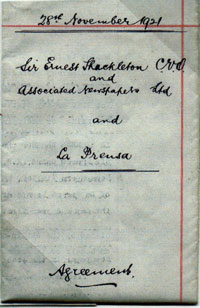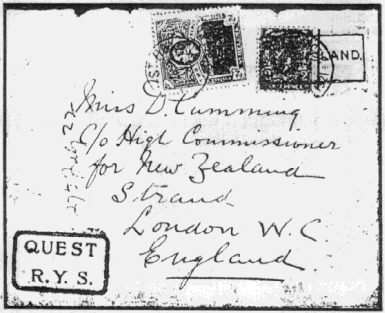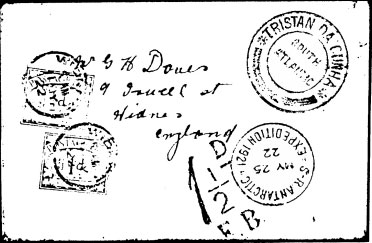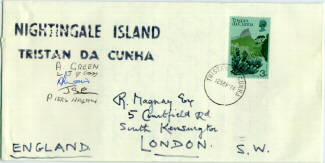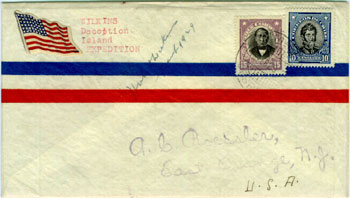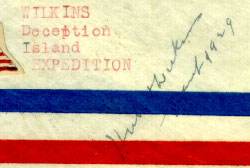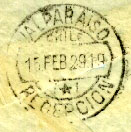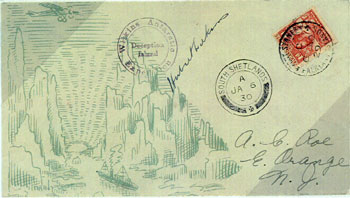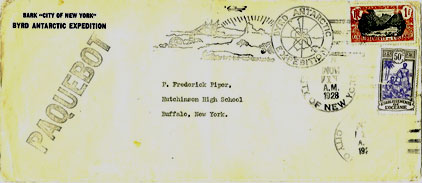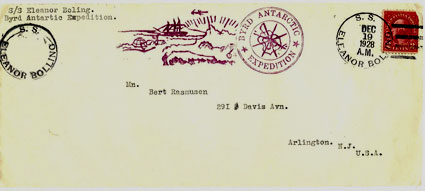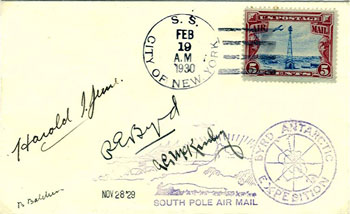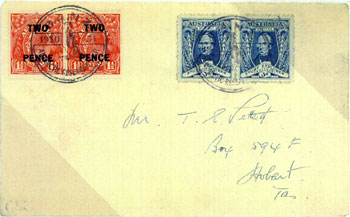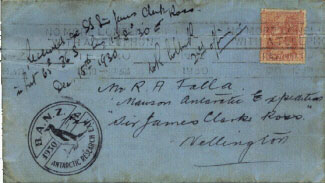U.S. Magnetic Research
Expedition
1915-17
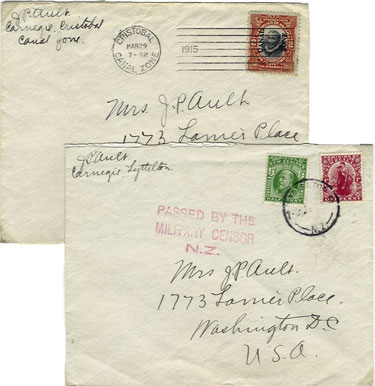 |
These covers, from the fifth of a series of voyages, were posted by James P. Ault who captained the wooden research ship S.Y. CARNEGIE on a worldwide magnetic declination expedition that included a circumnavigation of Antarctica in 1915-16. The expedition searched for the 'Nimrod Islands' and 'Dougherty's Island', confirming their nonexistence. The vessel visited the Falkland Islands and South Georgia and attempted, unsuccessfully, to land on Bouvet and Kerguelen. Ault wrote frequently to his wife, periodically sending her completed scientific expedition reports. The top cover was posted from his passage of the Panama Canal (Cristobal, 29 March 1915) en route to New Zealand that included a stop at Lyttelton, New Zealand (bottom cover), 7 December 1915, en route to Antarctic waters. Both are properly rated with the New Zealand cover also being subject to WWI civilian censorship from a British Dominion country. |
|
Scientific report-size envelope sent by Captain Ault of S.Y. CARNEGIE to his wife in the States, at the end of its worldwide cruise that included the circumnavigation of Antarctica, from Buenos Aires, 3 March 1917. The ship was ordered halted here from heading back to the United States to protect itself from surface and submarine attack after the United States was no longer a neutral nation in WWI. Cover franking pays the rate for eighth weight class plus 12¢ Registration fee. (Courtesy of Herb & Janice Harvis) |
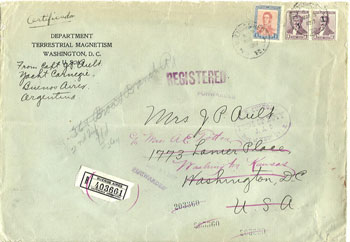 |
ERNEST
SHACKLETON
Shackleton-Rowett
Expedition
1921-22
|
|
During
1921, Sir Ernest Shackleton was busy planning his expedition to the
Antarctic. Keenly aware that this expedition should be recorded postally,
Shackleton made a personal call to Mr. Kelway of the post office on
September 5 with a request for a supply of overprinted stamps and a
datestamp, similar to those authorized by the New Zealand postal authorities
for his expedition
to King Edward VII Land in 1908. Flattered by Shackletons personal
calling, Mr. Kelway introduced him to Postmaster General Williamson.
Overprinting stamps was simply out of the question but an alternative
solution was to make Sir Shackleton an unpaid agent of the Postmaster
General on board the Quest. He would be issued a credit stock of stamps
and a set of expedition rubber datestamps which could be used for canceling
the stamps at whatever uninhabited place he visited. The Foreign and
Colonial Branch would supply the stamps to the Post Office Stores Department
with datestamps supplied within 48 hours. The following day Shackleton
placed a request for a stock of stamps to the value of £100. As
for a datestamp, he suggested that the expedition be supplied with an
ordinary metal datestamp. Additionally, a small number of rubber stamps
were requested showing the name of the territories in which the letters
would be posted. A small stock of mail bags, string, lead seals, sealing
press, letter bills and registration forms would also be required.
Shackleton was told that the rubber stamps would need to be larger than the postage stamps, otherwise they would be considered an "overprint" -- an increase in size would eliminate any confusion as to whether the stamps were canceled or simply overprinted. A post office was established on board the QUEST, complete with a stock of stamps, 50 mail bags, bag seals, certificate of posting book, registration labels, advice lists for registered correspondence, notices concerning postage rates and simple instructions as to how to make up mails. A notice reminded Shackleton than an extra 3d. Registration fee was required for registration in addition to 2d. for the 1st. ounce, and 1½d. per additional ounce. Shackleton assumed that most of the mail would be sent by registered post, though for what reason is not known. No record of any registered items from the QUEST has been recorded. All supplies and stocks of stamps were ready within twelve days. Mr. Kelway sent a telegram to Shackleton, now on board the QUEST at St. Katherine's Dock in London, which stated that "The Postmaster General and staff of the General Post Office wish you and those accompanying you in the QUEST all good wishes and safe return from your adventurous voyage in the Antarctic. -- Kelway". The expedition was plagued with bad luck from the very beginning. The ship was not reliable and much time was lost while waiting for engine repairs at Madeira and Rio. The outbound callings at South Trinidad, Tristan da Cunha and nearby Nightingale and Inaccessible Islands, Gough Island and Cape Town all had to be scrapped. The ship sailed straight for South Georgia and arrived there on January 4, 1922. During the early morning of the following day, Sir Ernest Shackleton died. The men were shattered by the loss, however the QUEST continued to sail southward after leaving South Georgia. They later returned to South Georgia from where, during the voyage to England, the QUEST visited Tristan da Cunha on May 20, 1922. Mail for members of the settlement was on board, which due to the changes brought about by earlier engine trouble, was now delivered seven months later than intended. The QUEST stayed five days at Tristan, leaving on the 25th of May. Before they left they took aboard the mail destined for England. Covers were struck with the single ring datestamp of the expedition together with the Tristan Type II cachet, but for one example struck with the Type III cachet. No use was made from Tristan with the stock of stamps or the rectangular Tristan cachet supplied by the Post Office. The boxed cachets had already been used philatelically as souvenirs for the crew with the cachet, because of its size, extending across a pair of stamps and overstruck with the expedition datestamp. The earliest known use is thought to be January 14, 1922. A block of four ½d. stamps with the Tristan boxed cachet and the datestamp reading "21" in error for the year was reported in 1954. The QUEST left Tristan for Gough Island from where at least one cover was prepared with the boxed Gough Island cachet. The expedition datestamp and also the ship cachet of the QUEST was applied, making this item an extraordinary postal history example from the Shackleton-Rowett Expedition. On arrival in London, the mail was taken to the Foreign Branch of the post office for processing. Unstamped covers were struck with the 1½d / FB / D surcharge handstamp and forwarded to their intended recipients without any other cancellations being applied. A note in the post office records of September 1922 reads: "I see from the papers that the QUEST has arrived at Portsmouth. We must get our datestamps back --." Letters to commander Frank Wild of the QUEST and follow-up notices to the expedition's headquarters in Eastcheap, London regarding these handstamps went unanswered. It was not until the following year that the datestamp, the boxed cachet handstamps and the balance of stamps from the expedition were returned to the G.P.O. in person by a "Mr. Cook". A memo notes that "After Mr. Cook had left, a further 1/ - stamp was found in the portfolio making the total of 1/ - values to £2-9-0d. The stamps are enclosed herewith and can perhaps be taken back into stock". A notation in the same record states that this was done and the amount outstanding against Sir Shackleton was £82-16-4 which represented the total of stamps cacheted and distributed among the crew as souvenirs. The breakdown by denominations is:
No doubt some of the above stamps were used for mail at Tristan on May 25th and Gough Island on May 27th, so it is safe to assume that the number of "souvenir overprints", especially complete sets, is very, very small. Mr. G. Olliffe, Receiver of the Shackleton-Rowett Expedition, was approached on March 10, 1923 concerning the balance owed the post office. There was no response so the post office wrote again demanding payment of the outstanding debt. Finally, on May 2 Mr. Olliffe responded and eventually paid the debt in full on June 12. The Post Office was now in balance and the books were closed.
|
Wilkins-Hearst Antarctic
Expedition
1928-30

